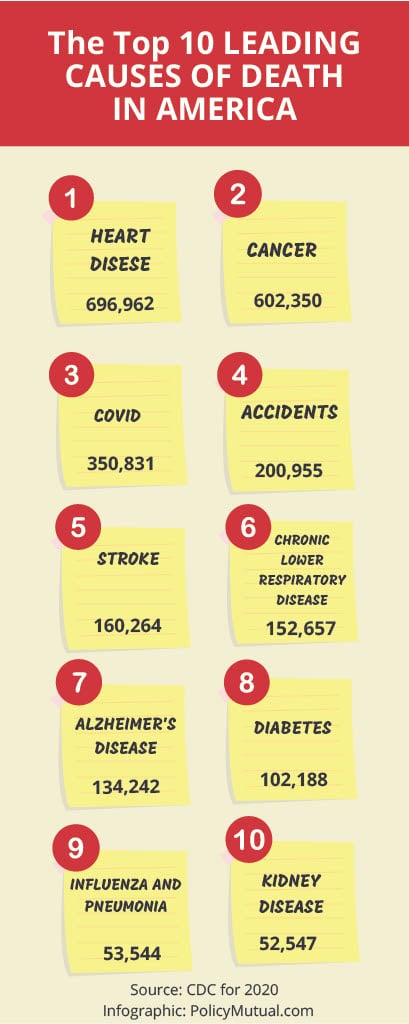Top Ten Leading Causes of Death in America & Life Insurance (Ultimate Guide) 2023

The United States was hit with the COVID-19 pandemic in 2020 which had a big impact on Americans’ physical and mental health. In fact, deaths overall from all causes increased 18% from 2019 to 2020. This was the largest single-year increase year-over-year ever on record. Approximately, 3,400,00 Americans passed away in 2020.2
While COVID is no longer the threat it once was, the leading causes of death remain as well as their impact on life insurance. Below are the top ten leading causes of death in the United States according to the CDC and their affects on life insurance eligibility, rates, and underwriting.
Table of contents
10 Leading Causes of Death in America
| Rank | Cause | Deaths per year |
|---|---|---|
| 1. | Heart disease | 696,692 |
| 2. | Cancer | 602,350 |
| 3. | COVID-19 | 350,831 |
| 4. | Accidents | 200,955 |
| 5. | Stroke | 160,264 |
| 6. | Lung disease | 152,657 |
| 7. | Alzheimer’s disease | 134,242 |
| 8. | Diabetes | 102,188 |
| 9. | Influenza and pneumonia | 53,544 |
| 10. | Kidney disease | 52,547 |
Source: CDC1

The 10 Leading Causes of Death in the United States and Their Affects On Life Insurance
1. Heart disease
Heart disease is the number one cause of of death in America. The term “heart disease” refers to several types of heart conditions which include:
- Heart attack
- Heart failure
- Cardiac arrhythmia
- Angina
- Heart valve diseases
- Congenital heart conditions
- Coronary artery disease- stents, bypass
- Heart infections- myocarditis, pericarditis, endocarditis
Heart Disease Life Insurance Rates: Life insurance rates and eligibility for those with a history of heart disease will depend on the type, age of onset, how many vessels were affected, and last time a cardiologist was seen. Minor heart conditions such as an innocent heart murmur may qualify for a Preferred rate with some insurers while severe heart issues such as a heart attack will likely be rated at substandard.
How heart disease affects life insurance underwriting:
- With a heart attack, stents or bypass (angioplasty) insurance companies will look at how many vessels were affected and age the of the onset to determine eligibility and rate.
- If three vessels or fewer were affected most companies will likely offer coverage.
- Most carriers require a 6 month to 1 year waiting period after a cardiac event or treatment to be eligible to apply for life insurance.
- When applying for life insurance with a history of heart disease, life insurance companies typically like to see an echocardiogram, ekg or stress test from a cardiologist in the past 24 months.
- A family history of heart disease before the age of 65 will affect the rate for many carriers, however there are a few that will still offer the best rate class if there was no death of either parent.
2. Cancer
Cancer is the second leading cause of death in America. Cancer is a disease when the body experiences abnormal cell grow (uncontrollably) and potentially spreads to other parts of the body. There are more than 100 different types but some of the most common include:
- Skin
- Lung
- Prostate
- Breast
- Colorectal
- Kidney
- Bladder
- Non-Hodgkin’s
- Thyroid
- Pancreatic
- Bladder
- Leukemia
Cancer History Life Insurance Rates: A history skin cancer with basal cell carcinoma or squamous cell carcinoma will typically not affect life insurance rates, with most insurers. A more severe cancer history typically results in a standard or substandard rate depending on the type, stage, age of onset and last treatment date.
Underwriting life insurance for a cancer survivor, underwriters will look at:
- Type of cancer
- Age of onset
- Stage
- Last treatment date
Family history of cancer:
- A family history of cancer can affect life insurance rates with many carriers. It’s important to shop rates with several companies to find one that has underwrites a family history of cancer more favorably.
There are other factors that go into underwriting cancer survivors such as routine screenings and overall healthy history. Some cancers such as prostate will only require a year after the last treatment date with a negligible PSA to be eligible to be able to apply for life insurance while other types of cancer such as breast and leukemia require a longer waiting period from the last treatment date to be eligible for coverage.
3. COVID-19
COVID-19 was the third leading cause of death in the U.S. in 2020. Fortunately, COVID doesn’t typically impact on life insurance underwriting or pricing unless it was severe.
Life Insurance Rates and Eligibility After COVID: Having had COVID in the past typically does not affect life insurance rates or underwriting. If the applicant currently has COVID, the insurance company will want the applicant to wait for 30 days before applying.
COVID-19 life insurance underwriting:
- Some carriers may require the pulmonary function test results post COVID-19 recovery if it was severe. However, other carriers will not as long as the applicant is fully recovered.
- A recent positive test for COVID-19 will not affect life insurance rates or pricing.
- Whether the applicant is vaccinated or not vaccinated for COVID typically does not affect life insurance underwriting or pricing.
4. Accidents
Accidents and unintentional injury deaths are the four leading cause of death in America. The top 5 causes of accidental death are:
- Unintentional poising
- Motor vehicle accidents
- Unintentional falls
- Suffocation by ingestion
- Drowning
Life Insurance Rates for Accidents: All rate classes including Preferred Plus are available for accidents. Typically, the only time accidents will affect life insurance underwriting and pricing is if the applicant has a dangerous occupation or engages in dangers avocations such as mountain climbing and is at a much greater risk of an accidental death.
Underwriting accidents for life insurance:
- The only time accidents will affect life insurance underwriting or rates is if the applicant engages in dangerous hobbies or has a dangerous occupation.
5. Stroke
Strokes (cerebrovascular diseases) are the the fifth leading cause of death in America. The five types of strokes are:
- Ischemic
- Hemorrhagic
- TIA
- Brain
- Cryptogenic
Life Insurance Rates After A Stroke: A Preferred rate is typically unlikely, more common is a standard plus or standard rate class for a TIA. For a full stroke, the rates are typically substandard table rated unless 10 or more years have passed without any ongoing symptoms then a standard rate may be possible.
Underwriting life insurance with a stroke:
- Type of stroke
- Age when occurred
- Any residual affects
- Current medications being taken
- Smoking status
- What tests have been done
- Other medical conditions
6. Chronic lower respiratory disease (lung disease)
Chronic lower respiratory disease is the sixth leading cause of death in America. Chronic lower respiratory disease includes a group of conditions that affect the lungs. These include:
- COPD- Chronic obstructive pulmonary disease
- Emphysema
- Chronic bronchitis
- Asthma
- Lung diseases from: exposure to smoke, second hand smoke, air pollution
Life Insurance Rates for Chronic Lower Respiratory (Lung) Disease: Preferred and Preferred Plus rates are available for mild asthma while more severe respiratory diseases such as COPD will be table rated if the applicant qualifies. If the applicant has COPD and still smokes then they will be declined for life insurance. A guarantee issue policy may be the best option in this case.
Underwriting life insurance with a lung condition:
- Type
- Date of diagnosis
- Ever been hospitalized
- Tests completed
- Severity
- What medications are being taken
- Fev1 %
- Employed or disabled
7. Alzheimer’s disease
Alzheimer’s disease is the seventh leading cause of death in our country and the most common form of dementia. In 2020, it’s estimated as many as 5.8 million Americans are living Alzheimer’s Disease.3
Life Insurance Rates for Alzheimer’s disease: Unfortunately those with Alzheimer’s disease will be declined for traditional life insurance. A graded death benefit policy may be the best option.
Life insurance underwriting for Alzheimer’s disease:
- Alzheimer’s disease is usually a decline for traditional life insurance
8. Diabetes
Diabetes mellitus is the eighth leading cause of death in America. There are four types of diabetes:
- Type I
- Type II
- Prediabetes
- Gestational
Life Insurance Rates with Diabetes: Type II diabetes with a well-controlled A1c and later onset typically results in a standard to standard plus rates. Elevated A1c reading (over 7.0) often will be a standard or substandard rate depending on the insurance company. Type I diabetes will result in table rates if onset was diagnosed after the age of 15. If earlier, typically a decline. Gestational diabetes is typically offered a Preferred health class. Most life insurance will classify pre-diabetes once an A1c reaches 6.0 and up and then will offer the diabetic rates.
Life insurance underwriting for diabetes:
- Type
- Age of onset
- Last A1c reading
- Tobacco use
- If there is nephropathy
9. Flu and pneumonia
The flu and pneumonia are the ninth leading causes of death for Americans. Influenza and pneumonia are assumed to be responsible for an excess mortality, particularity in the elderly and people with commodities.
Life Insurance Rates After the Flu/Pneumonia: This doesn’t affect life insurance rates or underwriting. All rate classes are available with a history of the flu or pneumonia.
Life insurance underwriting flu and pneumonia:
- A history with flu or pneumonia does not affect life insurance rates
10. Kidney disease
Chronic kidney disease is the tenth leading cause of death in the United States. Kidney disease occurs when the kidneys are damaged and lose their ability to filter blood.
There are many types of kidney disease. Some of the most common include:
- Chronic
- Kidney stones
- Polycystic
- Urinary track infections
- Glomerulonephritis
Life Insurance Rates with Kidney Disease: Life insurance rates and eligibility with a history of kidney disease will depend on the type, onset and current condition. Minor kidney issues such as a UTI or kidney stones will typically not affect life insurance rates and all health classes are available including Preferred rates. More severe kidney issues such as those on dialysis will typically be declined for traditional life insurance.
Life insurance underwriting for kidney disease:
- If the applicant currently has a kidney stone, life insurance companies will want it to pass before an application is submitted.
- Applicants with a kidney transplant are eligible with some carriers if has been 3 or more years since the surgery and the patient is free from any complications from the transplant.
- Kidney donors are eligible for coverage with most carriers. Rates can vary so it’s important to choose the right insurer.
- Applicants receiving dialysis or are not eligible for traditional life insurance.
Conclusion
Knowing the top ten leading causes of death in America helps life insurance applicants understand how the underwriting process works, the risk involved for the life insurance company and why they are receiving the rates they are. Also, it shows just how important it is secure a life insurance policy before a potential health event arises.
The good news is if you do have any of these health conditions, there are several hundred life insurance companies in the United States and each life insurance company will underwrite you differently and offer you a different price. While one company may decline you another may insurance you. Also, one company may offer standard rates based on a preexisting condition while another may offer a preferred rates. This can result in a monthly premium difference of hundreds of dollars a month for the same coverage.
If you have any of these preexisting conditions or a family history of them it’s important to compare rates from several life insurance companies to ensure you will be approved and at the best health rating class. You can do this by calling each company individually or use a broker like us that do the shopping for you.
If you have medical condition or a family history of a medical issue, please reach out to us and we can do a quick quote to find you the best rate. You can give us a call or contact us online.
Compare rates from several life insurance companies
Use an independent agent or broker
Ask the broker to do a quick quote
Let your doctors office know you are applying for life insurance
FAQ
What types of death are not covered by life insurance?
What is a life insurance policy incontestability clause?
Does life insurance cover suicide?
Does the cause of death impact a life insurance payout?
Does COVID affect life insurance rates?
Does vaccination status affect life insurance?
How long does a life insurance policy have to be active to payout?
Keep Reading
- Life Insurance Company Ratings
- 54 Top Life Insurance Statistics 2023
- Average Cost of Term Life Insurance 2023
- AARP Term Life Insurance Rates by Age 2023
- Best Rated Life Insurance Companies 2022
- A+ Rated Life Insurance Companies 2023
Resources:
